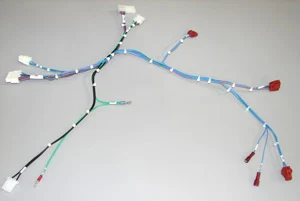Cable assembly vs. wire harness may sound like the matchup between two rival football teams, but in the day-to-day world of communications, networking, electricity and all manner of connectivity, it’s not a matter of rivalry, but knowing one from the other. Cable assemblies and wire harnesses are necessary components with varied applications for any number of the industrial, commercial, consumer, and public and private service sectors. The list is exhaustive—telecommunications, industrial and consumer electronics, automotive, medical, manufacturing, military, computing, aerospace, semiconductors, governmental agencies, and so on.
Though cable assemblies and wire harnesses are each used to transmit signals or electrical power, they are very different in complexity and use.
The difference between cable assemblies and wire harnesses is that cable assemblies create a path from one point or circuit to another, while wire harnesses connect several points or circuits with multiple breakouts running in different directions, serving multiple functions with multiple terminations on each breakout.
Cable Assembly
Cable Assemblies are one or more wires that run together in a single sleeve with a connector or plug on each end. Cable assemblies may be groups of wires or cables bundled together. Wrapped by a thermoplastic or vinyl sleeve, cable assemblies are ideal for routing groups of wires and cables around obstacles. Cable assemblies are designed to perform specific functions as determined by the plugs, terminals, and connectors that are found on each end. They are used in most electronic applications, from flat panel displays to the automotive electronic system to integrated cockpit systems to simple LED lighted clothing, costumes and accessories.
What are Cable Assemblies Used For?
Cable assemblies converge or interconnect different circuits or electrical paths to function together to transmit signals or power. They generally have only two ends to connect point A to point B.
For example, ethernet cable assemblies are designed to provide service supporting bandwidth speeds up to 10 Gigabit Ethernet, such as large data centers, military field units, and medical facilities. For those applications requiring a lightweight, smaller assembly that can transmit clearly and rapidly over great distances, support greater bandwidths, with high voltage isolation, then fiber optic cable assemblies would meet those needs. Industries that utilize fiber optic cable assemblies include aerospace, automotive, industrial, medical, and military applications.
Wire Harness

A wire harness is a method that incorporates several point to point cable assemblies together into one conclusive assembly. Thy are generally held together using cable ties or some form of protective sleeving used to protect the wires or cables from environmental conditions like moisture, heat or friction, and to organize the different breakouts for easy routing through a system or box build.
What are Wire Harnesses Used For?
Though a wire harness may be confused with a cable assembly, the main difference is that wire harnesses usually contain several ends or breakouts, running in different directions, serving multiple functions with multiple terminations on each breakout.
Custom wire harnesses are used in durable goods like household appliances, in and around engines of all kinds – automobiles, buses, locomotives, trucks, and even planes. Electronic equipment, construction machinery, industrial equipment, HVAC products all use wire harnesses.
Cable assemblies and wire harnesses are necessary components for all types of networking, connectivity, communication, and power supplies. Whether you need a custom cable assembly or a harness for a job will depend on the application requirements. With an understanding of the different functions between the two, you can easily choose the right component to fulfill the job requirements.


